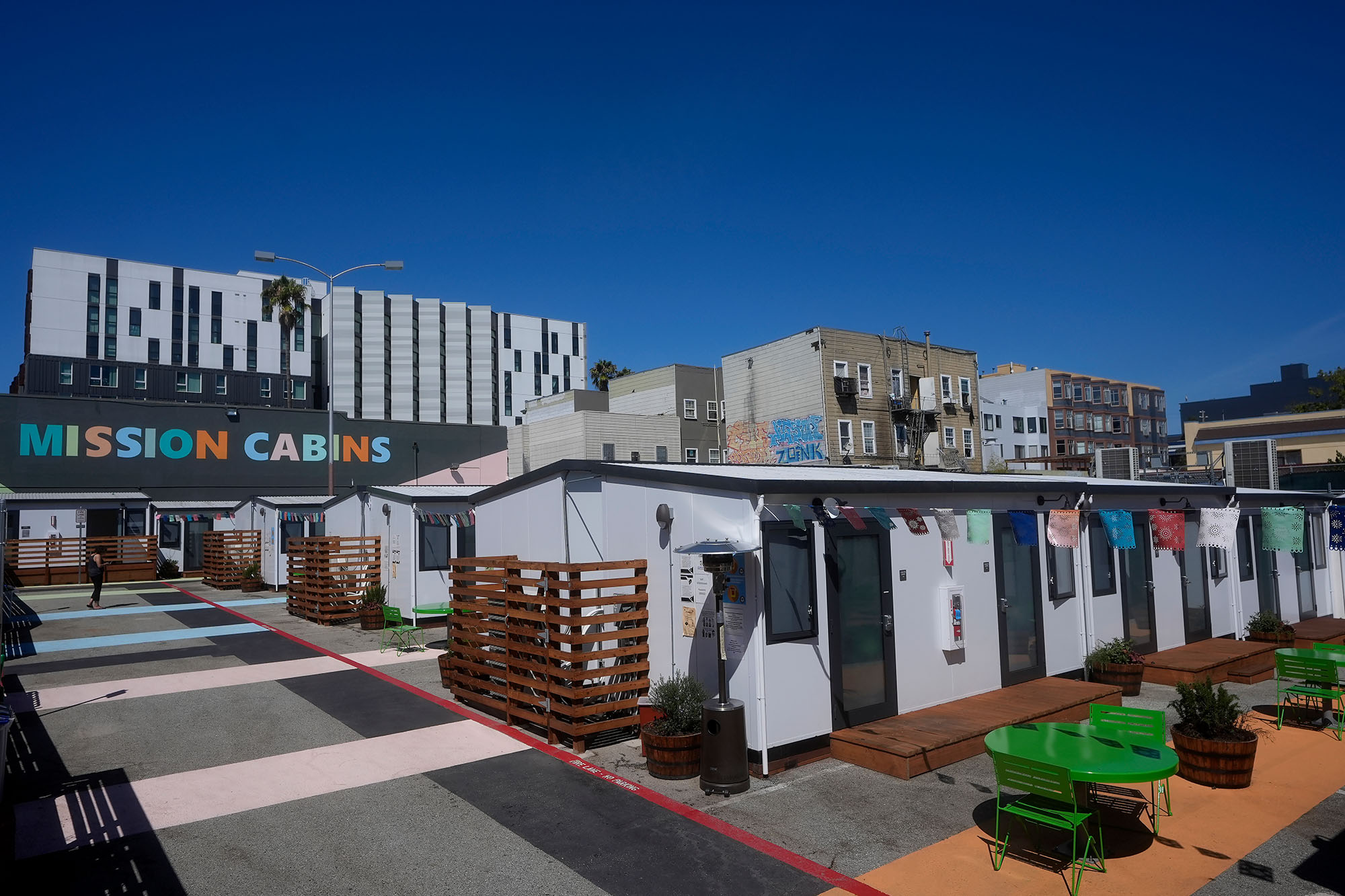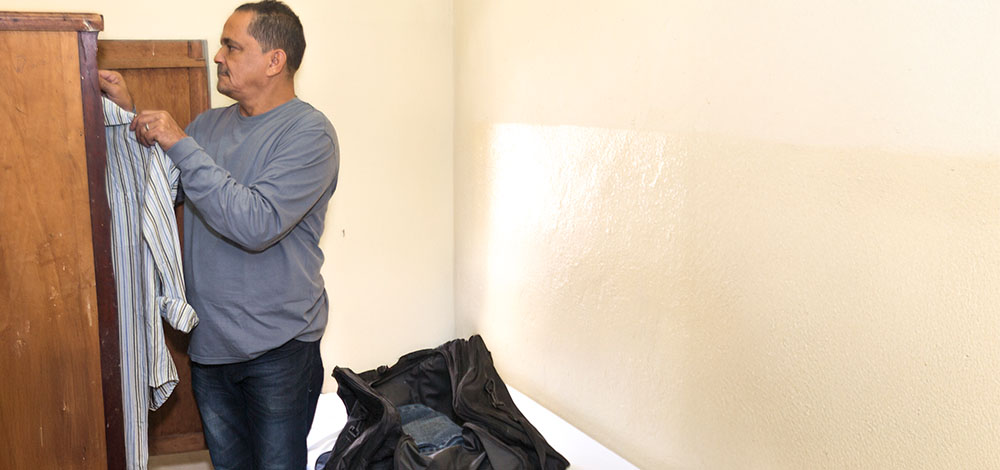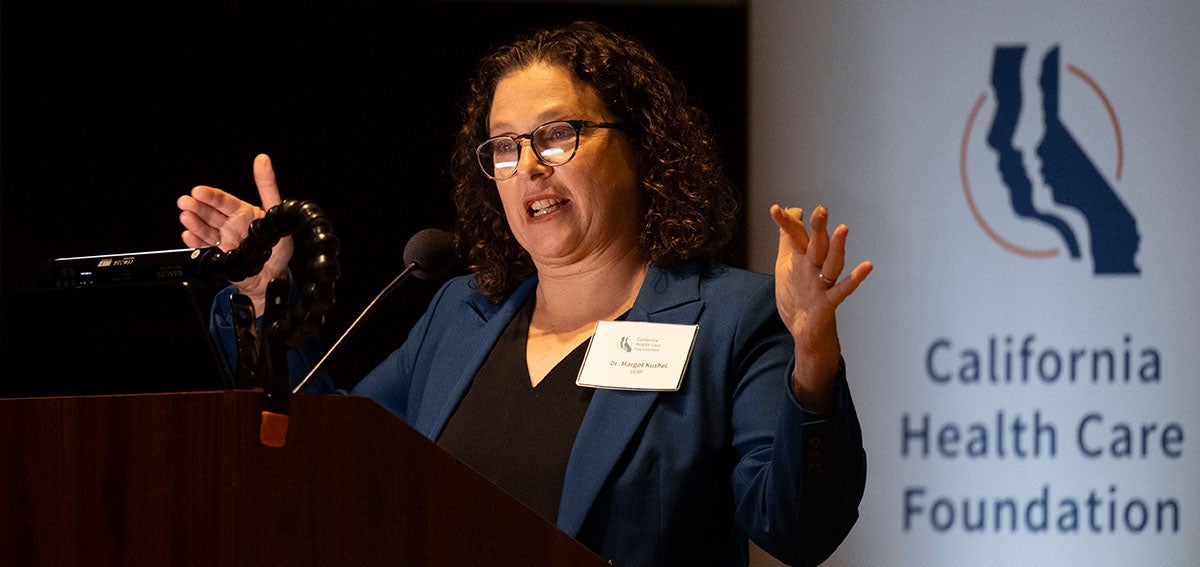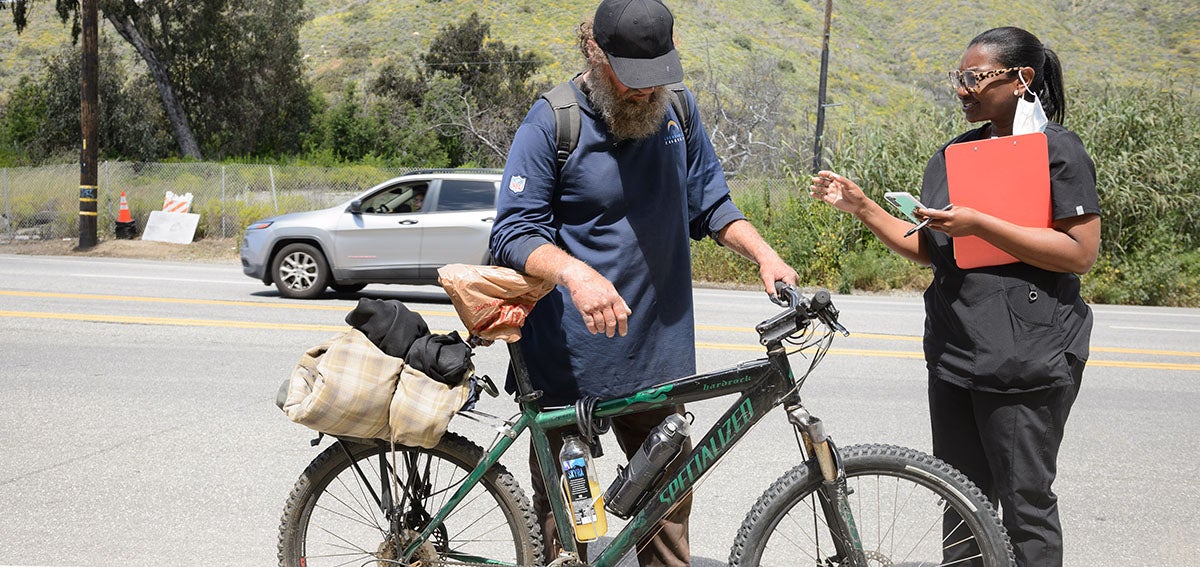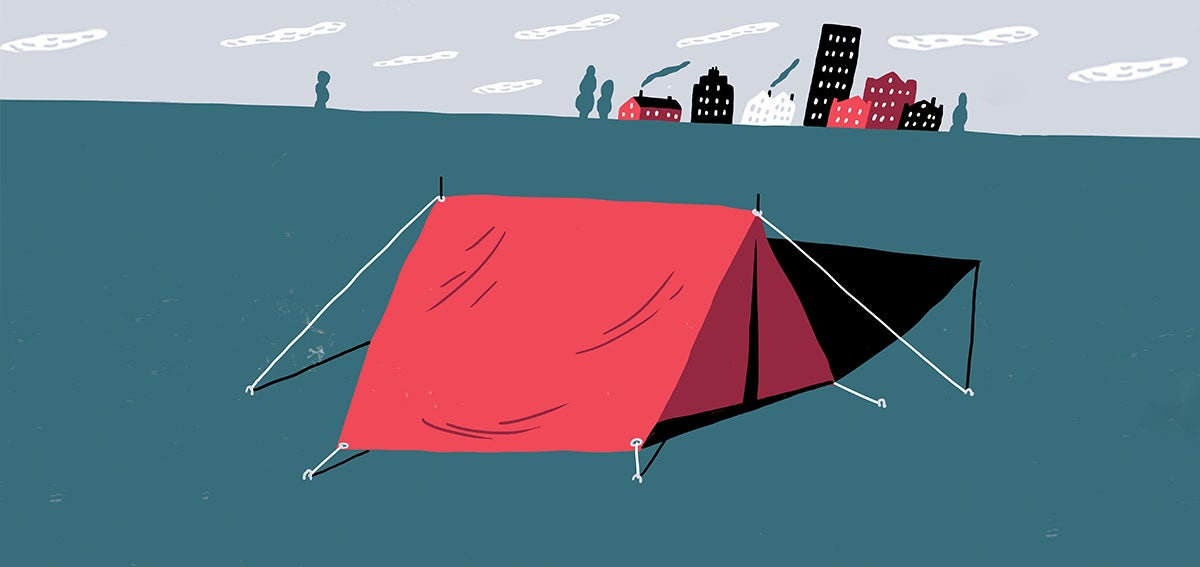
The 50-something man in a wheelchair was in so much pain that he couldn’t talk when he arrived at the hotel-turned-shelter in the Los Angeles suburb of El Monte in spring 2020.
For months, he had lived on the street — sleeping, eating meals, even urinating in his wheelchair. An immobilizing health condition left him unable to work. He lost his job and the room he rented. With the COVID-19 pandemic intensifying, California’s statewide Project Roomkey program was moving people experiencing homelessness indoors into hotels and motels managed by homeless service providers, and the man finally had a bed to sleep in. But he needed medical attention too. Sores covered the backs of his legs and buttocks.
“I was just mortified to see this man this way,” said Mayra Chaidez, the divisional homeless services director for the Salvation Army, which was overseeing the El Monte motel site.
The man had no means of transportation, no health insurance, and no energy to get himself to a doctor. Normally, this would create a logistical headache for staff because most shelters for people experiencing homelessness don’t have on-site medical personnel. But on this occasion, a doctor and nurses from the nearby East Valley Community Health Center were available at the shelter to evaluate and treat the man. A grant program called Health Pathways Expansion (HPE) had enabled the health center to bring providers and medical equipment directly to the Project Roomkey site to treat people during the pandemic.
“That was a savior,” said Chaidez. “It was like, we’re going to see you, we’re going to help you. That made the world of a difference.”
New Partnerships Blossomed
“By the end of the Health Pathways Expansion grant period, many participating medical providers said they had developed new or stronger relationships with the homeless services organizations they partnered with and with other nonprofit and government agencies serving people experiencing homelessness. Some planned to work on new projects together. For example, the Central Neighborhood Health Foundation is now referring patients in need of housing to SRO Housing Corporation after they worked together at a Project Roomkey hotel. Evonne Biggs, Venice Family Clinic’s program manager for homeless services and health equity, said the clinic started providing regular medical services at St. Margaret’s Center in Inglewood after the organizations connected.” — Claudia Boyd-Barrett
Mounting an Emergency Response
Developed by the United Way of Greater Los Angeles and funded through philanthropic partners, HPE distributed $2.3 million to 13 primary care and three behavioral health and substance use treatment organizations and clinics in Los Angeles County between August 2020 and June 2021. The funding allowed these provider organizations and clinics to deliver care to people experiencing homelessness at more than a dozen Project Roomkey sites and other interim shelters for up to a year. Altogether during the grant period, more than 3,500 clients were treated and received more than 14,000 health care consultations.
An evaluation funded primarily by CHCF concluded that the program effectively allowed grantees to mobilize quickly to bring care to people experiencing homelessness at Project Roomkey locations during the pandemic and helped them build relationships with patients who usually are hard to reach. The program also broke down barriers to accessing medical, behavioral, and substance use treatment services for people experiencing homelessness by bringing care directly to them, the evaluation found.
“We explicitly targeted providers who didn’t necessarily have a strong relationship with the homeless services sector and tried to provide that resource, that incentive.“
—Eric Ares, United Way of Greater Los Angeles
Because many clients were elderly with preexisting health conditions, they were at high risk for health complications from COVID-19. While the HPE program aimed primarily to safeguard their health during this vulnerable time, it presented an opportunity to test a concept that agencies and philanthropies had discussed for years — connecting health care providers with homeless services organizations to deliver medical care and health plan enrollment outside a traditional clinic setting, including homeless shelters, motel/hotel shelters, and outdoor locations.
“There are some [primary care] providers that partner very well with homeless service providers, but it’s not happening at scale,” explained Eric Ares, homeless initiatives senior manager with the United Way of Greater Los Angeles. “We explicitly targeted providers who didn’t necessarily have a strong relationship with the homeless services sector and tried to provide that resource, that incentive.”
HPE encouraged its grantees to use the money as they deemed necessary to provide care. This included paying for medical and support staff, administrative costs, and capital expenses. Some grantees said this flexibility made it easier to provide medical care outside of a traditional clinic setting. The grants allowed them to purchase items and cover staff time not typically reimbursed by Medi-Cal, California’s Medicaid health insurance program for residents with low income.
On the Road
The grantees took different approaches to delivering care. Some, like Harbor Community Health Centers, saw patients under pop-up canopies outside the hotels and motels to minimize the risk of COVID-19 spread. Others, like nonprofit health agency JWCH Institute, visited Project Roomkey sites in a medical van. Several tended to patients in designated spaces at Project Roomkey hotels and on occasion visited clients in their rooms, an important service for those with mobility challenges. Some providers used telehealth to see established patients when Project Roomkey hotels had to lock down because of a COVID-19 infection.
Kathy Proctor, clinic administrator at Northeast Valley Health Corporation, a Federally Qualified Health Center, said the HPE grant paid for a case manager to assist a medical team tending to patients at Project Roomkey sites. The case manager, who worked from the clinic offices, made sure patients followed through on referral and treatment recommendations and helped them with myriad other needs, such as obtaining phones, identification documents, pet food, and legal help. While Medi-Cal reimburses some of this case management activity, it’s often not enough to cover the complexity of these clients’ needs and the amount of time required to help them coordinate activity, Proctor said. Meanwhile, JWCH retrofitted a van to create the organization’s first mobile medical unit serving people experiencing homelessness in the Antelope Valley, said CEO Al Ballesteros.
Some clients who initially declined treatment eventually agreed to receive it after they got to know and trust the medical staff and saw them returning to hotel sites regularly.
At Harbor Community Health Centers, Clinical Practice Manager Brandi Aguilar used grant funds to purchase a pop-up canopy, foldable chairs and tables, laptops, scanners, and Wi-Fi hot spots so her team could see clients outdoors at Project Roomkey sites as well as record medical information for electronic health records, make referral calls, and submit insurance enrollment documents.
“I was able, with the grant, to buy the things that we really needed that were kind of costly,” she said. “Once we had those items, the rest . . . worked out on its own.”
Serving Thousands
Most providers offered basic medical services, such as performing vital sign checks, providing wound care for skin problems, ordering prescriptions, and doing physical exams. Some provided behavioral health screenings and treatment. For more complex physical or behavioral health problems like substance use disorder, providers encouraged patients to come into their regular clinic sites or referred them to other health care providers. They also worked to enroll uninsured clients in Medi-Cal or My Health LA (a no-cost health program for Los Angeles County residents with low incomes who are ineligible for other health insurance) and established primary care “medical homes” for patients, usually at one of the provider’s own clinics.
Altogether, almost 2,600 people who received care supported by HPE grants were referred to specialists, mental health or substance use disorder services, dentists, or to people who counsel clients about lifestyle changes. Close to 2,000 clients were enrolled in Medi-Cal, and nearly 3,000 established a primary care medical home.
Delivering nonemergency medical care to people experiencing homelessness is challenging because many are focused on day-to-day survival, providers said. They may lack transportation to get to appointments and may not have access to working phones and computers that would enable virtual visits. They may distrust health care institutions because of negative experiences or stigma. They may suffer from serious mental health or cognitive issues that both exacerbate stigma and make it difficult to plan or keep appointments.
Bringing care directly to people where they are made it easier for them to take advantage of it, providers said. The fact that clients served under HPE also had a safe place to stay during the pandemic gave them a chance to focus on their health and allowed medical teams to build trust and rapport with them. Some clients who initially declined treatment eventually agreed to receive it after they got to know and trust the medical staff and saw them returning to hotel sites regularly, several grantees said.
“It’s about really building relationships with people who are not trusting of anyone,” said Evonne Biggs, program manager for homeless services and health equity at Venice Family Clinic. “When they are encountering people who are taking the time to improve their health, that’s where that trust building comes in.”
New Cross-Sector Collaborations
Communication between the health care providers and homeless services staff managing Project Roomkey locations was a key to reaching people in need. Grantees reported difficulties at some Roomkey hotels and motels largely because of homeless service staff turnover and chaos related to the pandemic and COVID-19 outbreaks. Medical providers said it helped when Project Roomkey site staff helped spread the word about their services, identified clients needing help, and brought them to meet with the medical teams. Several HPE health care providers said they worked from the outset to establish and strengthen collaboration with homeless services staff by going on tours of the hotel/motel sites, meeting with site managers prior to the project’s launch, agreeing on points of contact for addressing problems, and scheduling regular check-ins.
Evaluators recommended that funders support care delivery to clients in nonclinic settings by helping health providers share strategies and best practices with one another in real time.
Joelle Green, director at Harder+Company Community Research, led an evaluation of the HPE program (PDF) funded primarily by the California Health Care Foundation. Her team did not fully assess the impact of the program on patient health due to data limitations and difficulty interviewing clients directly. However, from a provider perspective, the flexibility of the HPE funding effectively enabled grantees to bring care to people experiencing homelessness, she said.
“When you consider this project in the context of other integrated care and street medicine efforts, I think it certainly adds to the overwhelming evidence base that this site-based approach works, bringing care to where people are,” she said. “I think it’s going to take those kinds of integrated efforts to really get the outcomes we want for people, which is not only being stably housed but having a quality of life that they would want.”
Evaluation Recommendations
The evaluation conducted by Harder+Company Community Research concluded earlier this year after 18 key stakeholder interviews, reviews of program data, and in-depth case studies. One of the report’s top recommendations was that funders should support care delivery to clients in nonclinic settings by helping health providers share strategies and best practices with one another in real time. Evaluators say funders also should facilitate the strengthening of relationships among health care providers, homeless services organizations, and local government agencies. Efforts to provide more integrated care for Medi-Cal enrollees under the CalAIM (California Advancing and Innovating Medi-Cal) initiative offer the opportunity to replicate, fund, and scale future programs like HPE, the final evaluation report said.
For the man in the wheelchair in El Monte, receiving shelter and medical treatment through Project Roomkey changed his life. The East Valley Community Center team visited him weekly at the hotel, and he enrolled as a regular patient at their clinic. Salvation Army staff obtained a new battery for his wheelchair, arranged for a case manager, and found him a permanent place to live.
On the day they brought him to his new home, he had tears in his eyes as he thanked them, Chaidez said.
“He said he didn’t know if he would have made it if we hadn’t helped him,” she said. “For us, that was more than we could ask for.”
Authors & Contributors

Claudia Boyd-Barrett
Claudia Boyd-Barrett is a longtime journalist based in Southern California. She writes regularly about health and social inequities. Her stories have appeared in the Los Angeles Times, San Francisco Chronicle, San Diego Union-Tribune, and California Health Report, among others.
Boyd-Barrett is a two-time USC Annenberg Center for Health Journalism fellow and a former Inter American Press Association fellow.

Øivind Hovland
Øivind Hovland is a Norwegian-born illustrator based in the UK. His clients are mainly in the editorial field and are spread all over the world. Øivind is inspired by nature and uses his “Norwegianness” in his illustrations, exploring good and bad by drawing on endless fishing trips and playing with darkness and light inspired by the spectacular fjords of western Norway.

